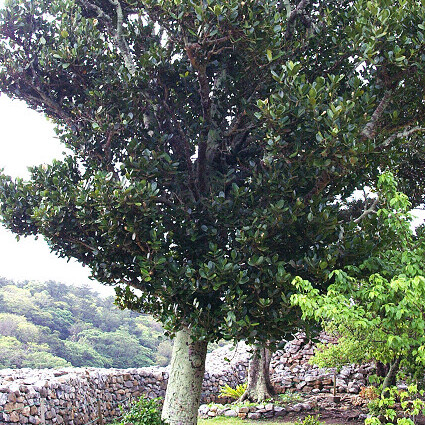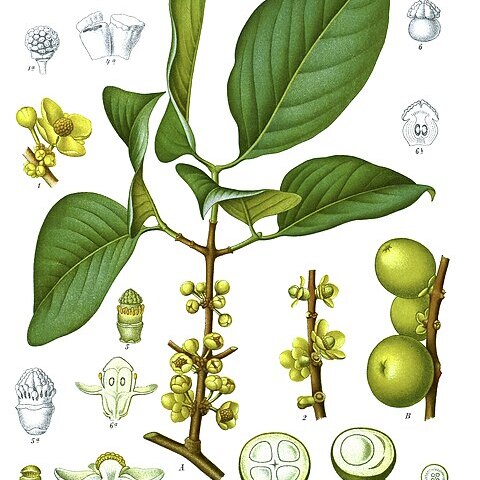Trees or shrubs, usually with yellow latex. Terminal bud functional; buds usually lacking scales. Leaves opposite [or rarely whorled], very rarely stipulate, petiolate, entire, leathery to papery, usually glabrous; secondary veins usually prominent, numerous to few, oblique to perpendicular to midvein; tertiary veins reticulate, with adaxial brownish transvenous resin canals [or much branched] and abaxial linear [to punctiform or much branched] or intervenous translucent glands; petiole often with basal liguliform appendage. Plant functionally dioecious (sometimes apparently flowers bisexual or plant monoecious), flowers in terminal and/or axillary cymes (often thyrsiform), triads or fascicles, or paired or solitary. Sepals [2 or 3 or]4 or 5, decussate or imbricate (quincuncial), free [or very rarely completely connate in bud]. Petals [3 or]4 or 5[-8], fascicles each with many to few stamens with filaments almost free to completely united, or ± completely connate [or adnate to petals], with anthers 1, 2, 4 or many-celled, basifixed or variously united; fasciclodes (sterile stamen fascicles) 4 or 5, antisepalous and free or ± united or absent; pistillode present or absent. Female flowers: staminode fascicles as for staminate flowers but smaller or staminodes apparently free; fasciclodes free as in male flower but smaller or united in a ring at base of ovary or absent; stigmas free or ± united, peltate, 2-5-lobed or entire. Berry smooth or sulcate [or verrucose or rarely secondarily dehiscent], with leathery to thin exocarp and 1-5 or sometimes more seeds embedded in endocarpic pulp. Seeds large; hypocotyl massive.
Erect shrubs or trees, mostly glabrous; sometimes dioecious or polygamous; sap yellow or white. Leaves opposite, simple, entire, mostly coriaceous with a prominent costa, lateral veins numerous, parallel, somewhat arcuate, becoming reticulate near the margin and forming a submarginal vein at or near the margin; petioles sometimes stout usually with an axillary wedge of tissue forming a pit; stipules wanting. Inflorescences fasciculate in the leaf axils or solitary and ter-minal, mostly small, pedicellate; bracts wanting or inconspicuous. Flowers per-fect or unisexual, sepals 2-4(-5), decussate, coriaceous, mostly imbricate; petals 2-4(-6), white, yellow or red; stamens numerous, inserted in one or more whorls or clusters, connate or free, the anthers variously dehiscent, rudimentary or want-ing in pistillate flowers; ovary inserted in an annular disc, mostly ovoid, the style usually short and stout, sometimes obsolete, the stigmas 3-12, coherent to form an entire or sinuate cap over the style, carpels 2-12, one erect ovule in each. Fruit a leathery berry or drupe, mostly 1 celled, the rind sometimes thick, smooth or tuberculate, the mesocarp often juicy and sweet; seeds 1-3, arillate, mostly ellipsoidal; embryo minute.
Trees to 30 m high; dioecious or polygamomonoecious; plant ±glabrous. Twigs smooth, striate or fluted. Leaves petiolate; petiole flat or channelled; lamina coriaceous to chartaceous, latex canals present; midvein above raised or flush. Inflorescences axillary or terminal, cyme, panicle, raceme, fascicle or solitary flower, pedicellate or subsessile. Flowers 4–30 mm diam. with distinct sepals and petals; sepals 2–5, persistent; petals 4–7, both imbricate; stamens aggregated into 4 or 5 bundles or phalanges (rarely 1), pistillode in male flowers present rudimentary to very well developed; ovary ovoid, 2 to many-locular, 1 ovule per locule, style 1, staminodes in female flowers present or absent. Fruit a berry with seeds embedded in the pulp, stigma or column persistent.
Male flowers with androecium of 4 (5) fascicles of stamens, each with filaments free or partially or completely fused together, the fascicles usually free in African species, with anthers sometimes transversely septate; and sometimes with a whorl of sterile stamen-fascicles ("fasciclodes") alternating with the stamen-fascicles or forming a cushion in which the stamens are inserted; ovary-vestige sometimes present.
Female usually with 4 (5) stamen-or staminode-fascicles, similar to those of the male flowers but smaller and with fewer members, and sometimes with fasciclodes, free or fused together in a ring at the base of the ovary; ovary globular, 2–5 (12)-locular; loculi 1-ovulate; styles absent; stigma sessile, broad, 2–5-lobed or entire, sticky.
Leaves opposite, or sometimes subopposite or whorled, petiolate, entire, coriaceous, with venation usually ± prominent, often with translucent glandular canals and brownish resin canals; petiole with a ± prominent ligulate appendage.
Flowers terminal or axillary, solitary or in few-to many-flowered cymes, fewer in the female or bisexual plants, dioecious or polygamous, rarely bisexual.
Sepals 4, decussate (or occasionally 5, quincuncial, or 3), free.
Trees or shrubs, rarely shrublets, secreting a yellow latex.
Fruit a 1–4-seeded ± fleshy berry, with tough epidermis.
Petals 4 (5), greenish-white to yellow.
Bisexual flowers like female.
Seeds large, arillate.


